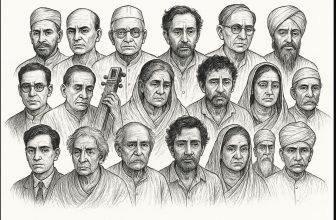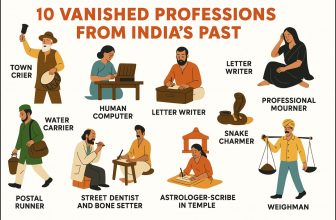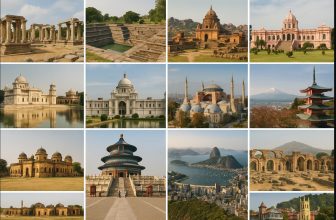India’s history is filled with extraordinary artifacts that provide a direct window into the art, culture, technology, and daily life of ancient civilizations. From sophisticated metallurgy to intricate sculptures and advanced city planning, these discoveries prove that India was home to some of the most technologically and artistically advanced societies of their time.
These rare historical artifacts, discovered across the country, continue to amaze historians and scientists, challenging our understanding of ancient India’s achievements in science, art, warfare, and trade. Some of these artifacts have even rewritten history, proving that India’s ancient civilizations were far more advanced than previously believed.
In this article, we explore 10 rare historical artifacts found in India that offer incredible insights into the country’s rich and diverse past.
1. The Dancing Girl of Mohenjo-Daro – A 4,500-Year-Old Bronze Masterpiece
- Discovery Site: Mohenjo-Daro (Indus Valley Civilization)
- Estimated Age: 2500 BCE
The Dancing Girl is one of the most famous artifacts from the Indus Valley Civilization. This 10.5 cm bronze statuette, discovered in Mohenjo-Daro, represents a young female dancer, showcasing the sophisticated metal-casting techniques of ancient artisans.
- She is adorned with intricate jewelry, indicating a developed sense of aesthetics and craftsmanship.
- Her confident posture, with one hand on her hip and the other holding an object, suggests an early appreciation for artistic expression.
- It remains a symbol of India’s rich artistic heritage, now housed in the National Museum, New Delhi.
- https://indianculture.gov.in/artefacts-museums/dancing-girl
- This artifact proves that dance, metallurgy, and artistic expression were deeply ingrained in Harappan society.
2. The Bimaran Casket – A Golden Relic of Buddhism and Greek Influence
- Discovery Site: Near Jalalabad, Afghanistan (Indo-Greek Kingdom)
- Estimated Age: 1st Century CE
The Bimaran Casket is a golden reliquary found in a Buddhist stupa, featuring images of Buddha and Bodhisattvas. This artifact is one of the earliest representations of the Buddha in human form.
- Its Greek-influenced artistic style suggests the influence of the Indo-Greek rulers.
- The casket was used to store sacred Buddhist relics, highlighting the spread of Buddhism in the region.
- It is currently housed in the British Museum, London.
- This artifact is a testament to the fusion of Indian and Hellenistic artistic traditions, revealing how Buddhism spread across Asia.
- https://www.britishmuseum.org/collection/object/A_1900-0209-1
3. The Akota Bronzes – Exquisite Jain Sculptures from Medieval India
- Discovery Site: Akota, Gujarat
- Estimated Age: 6th–12th Century CE
The Akota Bronzes are a collection of 68 Jain bronze sculptures, featuring Tirthankaras and other deities, discovered in Gujarat. These artifacts highlight the metallurgical expertise and spiritual devotion of medieval India.
- The sculptures are made using the lost-wax casting technique, a method still used today.
- They reflect the Gupta and post-Gupta styles of Jain art.
- Many of these bronzes are displayed in the Baroda Museum and Picture Gallery.
- These bronzes provide evidence of Jainism’s influence in medieval India and the refined metal-casting skills of Indian artisans.
- https://en.wikipedia.org/wiki/Akota_Bronzes
4. The Sultanganj Buddha – A Massive Bronze Statue from the Gupta Era
- Discovery Site: Sultanganj, Bihar
- Estimated Age: 7th Century CE
This 2.3-meter-tall bronze Buddha statue, weighing over 500 kg, is one of the largest surviving metal sculptures from ancient India.
- It was discovered during railway construction in Bihar in the 19th century.
- The statue is made of pure copper, using an advanced casting technique.
- Currently housed in the Birmingham Museum, UK.
- This artifact is a prime example of Gupta-era craftsmanship and reflects the spread of Buddhism through artistic expression.
- https://en.wikipedia.org/wiki/Sultanganj_Buddha
5. The Lothal Dockyard – A 4,000-Year-Old Harappan Port
- Discovery Site: Lothal, Gujarat
- Estimated Age: 2400 BCE
Lothal’s dockyard is one of the world’s oldest known ports, proving that Indus Valley Civilization had maritime trade with Mesopotamia.
- It featured a massive dock, built to handle large cargo ships.
- Drainage channels and warehouses suggest a well-planned trading hub.
- Various seals, pottery, and tools found here confirm advanced urban planning and commerce.
- The Lothal Dockyard is a testament to the Harappan civilization’s expertise in urban planning, engineering, and trade.
- https://www.gujarattourism.com/central-zone/ahmedabad/lothal.html
6. The Keeladi Excavations – Sangam-Era Urbanization
- Discovery Site: Keeladi, Tamil Nadu
- Estimated Age: 6th Century BCE
Excavations in Keeladi revealed ancient urban settlements, proving that the Tamil civilization was thriving during the Sangam period.
- Artifacts include pottery, terracotta figurines, and an advanced drainage system.
- The findings challenge the notion that the Indus Valley Civilization was India’s only advanced ancient society.
- These discoveries are reshaping South Indian history.
- Keeladi proves that advanced urbanization existed in South India nearly 2,600 years ago.
- https://sivaganga.nic.in/tourism/keezhadi-excavation/
7. The Sinauli Chariots – India’s Bronze Age Warfare Relics
- Discovery Site: Sinauli, Uttar Pradesh
- Estimated Age: 2000 BCE
The discovery of chariots with copper plating in Sinauli is changing our understanding of warfare in ancient India.
- These chariots suggest India had a warrior class using advanced vehicles during the Bronze Age.
- Found alongside swords, helmets, and shields, hinting at an organized military.
- Challenges the belief that horse-drawn chariots were introduced to India only later.
- These artifacts provide new evidence of warfare and metallurgy in ancient India, reshaping history.
- https://www.cambridge.org/core/journals/radiocarbon/article/royal-burials-and-chariots-from-sinauli-uttar-pradesh-india-radiocarbon-dating-and-isotopic-analysis-based-inferences/A33F911D8E6730AE557E1947A66A583C
Summary – Historical Relics That Redefined History
Each of these artifacts tells a unique story about India’s technological, artistic, and cultural advancements. From the sophisticated cities of the Indus Valley to the metallurgical genius of the Gupta era, these relics prove that India has been at the forefront of innovation for millennia.
As archaeologists continue to unearth more discoveries, India’s history becomes even more fascinating, proving that its past holds many more secrets yet to be revealed.





